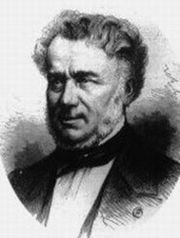
Victor Baltard
Encyclopedia

France
The French Republic , The French Republic , The French Republic , (commonly known as France , is a unitary semi-presidential republic in Western Europe with several overseas territories and islands located on other continents and in the Indian, Pacific, and Atlantic oceans. Metropolitan France...
architect, who was born in Paris
Paris
Paris is the capital and largest city in France, situated on the river Seine, in northern France, at the heart of the Île-de-France region...
, son of architect Louis Baltard
Louis Baltard
Louis-Pierre Baltard was a French architect, and engraver, born in Paris. He was originally a landscape painter, but in his travels through Italy was struck with the beauty of the Italian buildings, and changed his profession, devoting himself to architecture.In his new occupation he achieved...
.
Until 1833, Baltard studied at the École des Beaux-Arts
École des Beaux-Arts
École des Beaux-Arts refers to a number of influential art schools in France. The most famous is the École nationale supérieure des Beaux-Arts, now located on the left bank in Paris, across the Seine from the Louvre, in the 6th arrondissement. The school has a history spanning more than 350 years,...
, where he garnered the Prix de Rome
Prix de Rome
The Prix de Rome was a scholarship for arts students, principally of painting, sculpture, and architecture. It was created, initially for painters and sculptors, in 1663 in France during the reign of Louis XIV. It was an annual bursary for promising artists having proved their talents by...
for designing a military school in 1833. He went on to study at the Académie de France in Rome, Italy
Italy
Italy , officially the Italian Republic languages]] under the European Charter for Regional or Minority Languages. In each of these, Italy's official name is as follows:;;;;;;;;), is a unitary parliamentary republic in South-Central Europe. To the north it borders France, Switzerland, Austria and...
, from 1834 to 1838 under the direction of Jean Auguste Dominique Ingres
Jean Auguste Dominique Ingres
Jean-Auguste-Dominique Ingres was a French Neoclassical painter. Although he considered himself to be a painter of history in the tradition of Nicolas Poussin and Jacques-Louis David, by the end of his life it was Ingres's portraits, both painted and drawn, that were recognized as his greatest...
. From 1849 on, he was an Architect of the City of Paris
Architect of the City of Paris
The Architect of the City of Paris is a municipal position, responsible for the design and construction of civic projects in Paris, France....
. In this function, he was responsible for the restoration of several churches, as well as the construction of St. Augustin
Église Saint-Augustin de Paris
The Église Saint-Augustin de Paris is a church in the VIIIe arrondissement of Paris, France. Here Charles de Foucauld was converted by its priest, Father Huvelin. During the Second Empire, this area was undergoing considerable building work and demographic movement...
(1860–1867), in which he united the structural values of stone and steel. His most popular achievement was, however, the building of les Halles
Les Halles
Les Halles is an area of Paris, France, located in the 1er arrondissement, just south of the fashionable rue Montorgueil. It is named for the large central wholesale marketplace, which was demolished in 1971, to be replaced with an underground modern shopping precinct, the Forum des Halles...
, the central market in Paris, during the years 1851 to 1857. In 1972 and 1973, however, these halls were torn down again. A single hall (completed in 1854) was classified as a historical monument and moved to Nogent-sur-Marne
Nogent-sur-Marne
Nogent-sur-Marne is a commune in the eastern suburbs of Paris, France. It is located from the centre of Paris. Nogent-sur-Marne is a sous-préfecture of the Val-de-Marne département, being the seat of the Arrondissement of Nogent-sur-Marne.-History:...
in 1971, where it is now known as the Pavillon Baltard.
Victor Baltard also built the slaughter houses and the cattle market of Les Halles de la Villette, as well as the tombs of composer Louis James Alfred Lefébure-Wely
Louis James Alfred Lefébure-Wely
Louis James Alfred Lefébure-Wely was a French organist and composer.-Short Biography:Lefébure-Wely played a major role in the development of the French symphonic organ style and was a close friend of the organ builder Aristide Cavaillé-Coll, inaugurating many new Cavaillé-Coll organs.He began to...
at the Cimetière du Père Lachaise and jurist Léon Louis Rostand at the Cimetière de Montmartre. He was largely instrumental in introducing a regular scheme of fresco
Fresco
Fresco is any of several related mural painting types, executed on plaster on walls or ceilings. The word fresco comes from the Greek word affresca which derives from the Latin word for "fresh". Frescoes first developed in the ancient world and continued to be popular through the Renaissance...
decoration by modern artists in the churches of Paris, to take the place of the heterogeneous collections of pictures of all kinds with which their walls had been promiscuously decorated.

